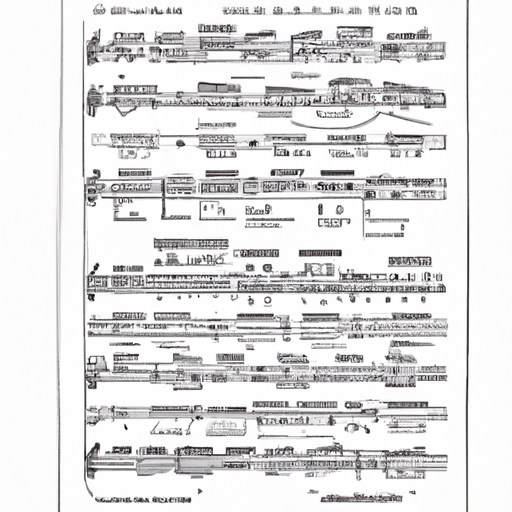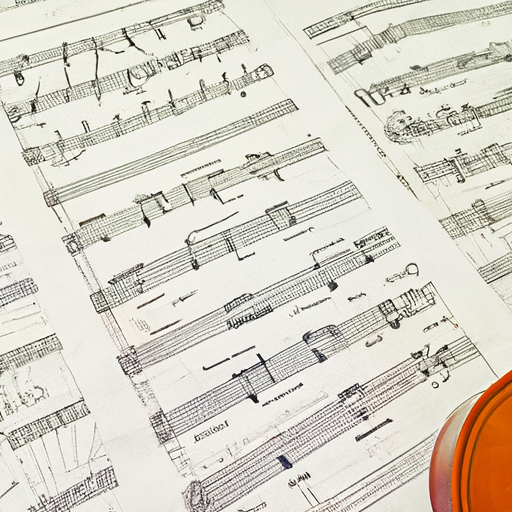
Sheet music is a written or printed form of musical notation that represents the melodies, rhythms, and harmonies of a piece of music. It provides a visual representation of the musical elements, allowing musicians to interpret and perform the music accurately.

For violin players, sheet music is an essential tool in learning and mastering the instrument. It not only helps in understanding the notes and fingerings but also provides a roadmap for playing the music with precision and expression.

There are several advantages to reading sheet music for violin players:
Before diving into reading sheet music for violin, it is important to understand the basics of music notation. Here are some fundamental elements:
A staff is a set of five horizontal lines, where musical notes are placed. It consists of lines and spaces that represent different pitches. Bars or measures are the spaces between vertical lines on the staff, dividing the music into small sections.
Clefs are symbols placed at the beginning of the staff to indicate the position of the notes. Violin music is usually written in the treble clef, which is represented by a stylized letter "G."
Notes are the symbols that represent the pitch and duration of a musical sound. The placement of notes on the staff indicates their pitch, and the shape of the notehead indicates their duration. Rests, on the other hand, represent periods of silence in the music.
Time signatures indicate the meter or rhythm of a piece of music. They consist of two numbers stacked on top of each other. The top number represents the number of beats in each measure, while the bottom number represents the type of note that receives one beat.
As a violin player, understanding the fingering system is crucial for reading sheet music accurately. Here are some key concepts:
The violin fingerboard is divided into different positions, each indicated by a Roman numeral. Each note on the staff corresponds to a specific finger placement on the fingerboard. By mapping the notes on the staff to the fingerboard, violin players can identify the correct fingerings for each note.
Positions refer to the placement of the hand and fingers on the violin fingerboard. Each position has its own specific finger patterns and hand shapes. By identifying the positions marked in the sheet music, violin players can determine the correct hand position for playing the music.
Finger numbers are used to indicate which finger to use for playing a specific note. The first finger is usually represented by "1," the second finger by "2," and so on. By paying attention to the finger numbers indicated in the sheet music, violin players can ensure accurate finger placement and coordination.
Now that we have covered the basics, let's discuss the process of learning to read sheet music for violin:
Beginners should start with simple songs that have a limited range of notes and rhythms. This allows for gradual learning and understanding of the sheet music notation. Some examples of simple songs for beginners include nursery rhymes and folk tunes.
It is important to familiarize yourself with the different notes and their corresponding values. This includes understanding the difference between whole notes, half notes, quarter notes, eighth notes, and so on. Practice identifying and naming the notes on the staff to improve your note recognition skills.
Regular practice is essential for developing sheet music reading skills. Start with exercises that focus on recognizing notes, rhythms, and fingerings. Gradually increase the complexity of the exercises and incorporate sight-reading practice to improve your fluency in reading sheet music.
Here are some techniques that can help you master the art of sheet music reading for violin:
Practice memorizing the note positions on the violin fingerboard. This will allow you to quickly identify the correct finger placement for each note, making the reading process more efficient.
Sight-reading is the ability to read and play a piece of music at first sight. Set aside dedicated practice time for sight-reading exercises. Start with simple pieces and gradually work your way up to more complex compositions.
Sheet music provides indications for dynamics and articulation, which allow for expressive and emotive playing. Pay attention to these markings and experiment with different techniques to bring out the intended emotion and expression in the music.
Dynamics and articulation are essential elements of sheet music notation that contribute to the overall interpretation and performance of a piece. Here's what you need to know:
Dynamics refer to the volume and intensity of the music, while articulation refers to the clarity and manner in which the notes are played. Dynamics and articulation markings are indicated by specific symbols and terms in the sheet music.
Sheet music uses various symbols and terms to indicate dynamics and articulation. Some common dynamics symbols include "piano" (soft), "forte" (loud), "crescendo" (gradually getting louder), and "diminuendo" (gradually getting softer). Articulation symbols include staccato (short and detached), legato (smooth and connected), and accent (emphasized attack).
When reading sheet music, pay close attention to the dynamics and articulation markings. Experiment with different bowing techniques, bow pressure, and fingerings to bring out the desired dynamics and articulation in your playing.
As you delve deeper into sheet music reading, you'll come across specific terms and notations. Here are some commonly used terms in sheet music:
For a more comprehensive list of sheet music terms, refer to the glossary of sheet music terms for beginners.
Here are some tips to enhance your sheet music reading skills:
Sheet music reading requires concentration and focus. Minimize distractions and create a dedicated practice space where you can fully immerse yourself in the music.
Consistent practice is key to improving your sheet music reading abilities. Set aside regular practice sessions and make it a part of your daily routine.
A qualified violin teacher can provide valuable guidance and feedback on your sheet music reading skills. They can help you correct any mistakes, suggest effective practice techniques, and offer personalized instruction.
Here are some common mistakes violin players should avoid when reading sheet music:
Take the time to carefully study and interpret the notes and symbols in the sheet music. Misinterpreting a note or symbol can lead to incorrect fingerings, rhythms, or dynamics.
Accuracy in intonation is crucial for violin players. Pay attention to the pitch of each note and use the correct finger placement to ensure accurate tuning.
Sheet music provides indications for the tempo and rhythm of the music. Neglecting to follow these indications can result in a disjointed and uncoordinated performance.
Reading sheet music for violin is an important skill that opens up a world of musical possibilities. By understanding the basics of music notation, mastering the violin fingering system, and practicing regularly, you can become proficient in reading sheet music.
Remember to maintain focus, seek guidance from a teacher, and avoid common mistakes. With dedication and patience, you can unlock the joy of playing the violin and bring beautiful music to life.
For further study and practice, explore the recommended resources below:
Embrace the journey of learning sheet music reading for violin and enjoy the beauty of this timeless instrument.